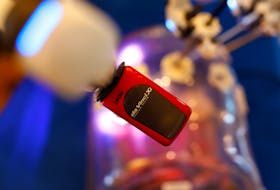Summerside - While there are no “silver bullets” for combating wireworm, with ongoing research, Island farmers do have more options.
Dr. Christine Noronha, of Agriculture and Agri-Food Canada, has unveiled an effective wireworm trap.
“The trap is a very simple light trap, called the NELT™. It uses a solar powered light source to attract the adults of wireworms, click beetles. The beetles walk to the light and fall into a cup buried in the ground under the light,” explained Noronha.
This is the first trap that catches female click beetles.
Trapping the egg-laying females will gradually help reduce the wireworm population in the field.
“This method used in combination with the rotation of crops, brown mustard, and planting of buckwheat can be used in an integrated pest management strategy to reduce populations on the Island,” she added.
Wireworm is a growing concern for farmers because the invasive species chews through crops and makes them unfit for sale, and can live in the soil for more than four years.
“They feed and survive on many crops – corn, wheat, barley, potatoes, rutabagas, onions, carrots, cabbage and strawberry seedlings to name a few. They have a very wide host range,” said Noronha.
The serious pest costs the industry millions of dollars of damage each year.
“The species that we have on P.E.I. is a European species which is very aggressive. And because we are an Island, with a limited land mass, the beetle can easily move around and lay eggs,” she observed. “Our moist climate is also conducive to egg survival.”
P.E.I. Potato Board general manager, Greg Donald said, “Nature doesn’t occur in a vacuum.”
If we change something in the environment, something else will happen.
“Changes in crop production and improvements in farming practices have led to wireworm evolving from a relatively minor pest on the Island to one of economic importance,” he said.
But hope continues to grow.
Other species used to “bait and kill” pest populations have been introduced on P.E.I.
“There is research using a fungus (called Metarhizium) to help control, but it’s still under research yet to be commercialized,” explained Donald.
Here’s how it works: When wireworm or click beetles are exposed to Metarhizium spores, the spores attach to the insect and kill it.
Donald and Noronha, however, both agreed that an integrated approach works best.
These multiple actions can include soil preparation, planting date, variety of crop, crop protectants, harvest date, as well as cover crops like brown mustard and buckwheat, which aid in pest control.
“Farmers are very knowledgeable about managing this pest, P.E.I. Potato Board resources, P.E.I. Department of Agriculture, Agriculture Canada, and various industry representatives,” concluded Donald.









